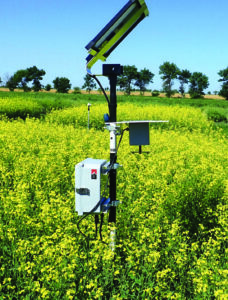Spore threshold for sclerotinia stem rot risk
KEY RESULT:
Frequent occurrence during the flowering period of a minimum of 0.0001 nanograms of S. sclerotiorum DNA per petal or per cubic metre per hour combined with relative humidity over 80 per cent and cooler temperatures are expected to result in a disease incidence greater than 10 to 15 per cent. In this situation, fungicide is recommended, depending on commodity price and expected yield.
PROJECT TITLE, PRINCIPAL INVESTIGATOR:
“Improving the management of sclerotinia stem rot of canola using fungicides and better risk assessment tools,” Kelly Turkington, Agriculture and Agri-Food Canada Lacombe
FUNDING:
AgriScience Program (Canola Cluster) under the Canadian Agricultural Partnership
PUBLISHED ARTICLES:
Read the full report on the Canola Research Hub.
Results from this study emphasize that without a minimum threshold of spores and constant high relative humidity, risk from sclerotinia is low and fungicide is not economical.

Researchers aimed to (1) refine the use of qPCR analysis and investigate the potential of utilizing spore traps instead of canola petals; (2) understand the role and impact of relative humidity (RH), rainfall, and temperature on inoculum production and disease development; (3) evaluate the efficacy of very early applications alone or in conjunction with later applications of fungicide for management of stem rot; (4) develop a better understanding of factors (e.g. seeding rate) that influence crop development and variability in flowering and how this influences fungicide response at various crop growth stages; and (5) develop a better understanding of how inoculum availability and environmental conditions prior to and during the flowering period influence stem rot risk and the efficacy of fungicide application.
Results
 Given weather conditions and relatively low inoculum levels, most sites showed limited disease development and no effects of fungicide timing and their interaction on yield. Trial sites at Outlook, Saskatchewan and Brooks, Alberta were irrigated yet inoculum loads and weather conditions were not overly favourable for stem rot development. Perhaps for these locations where warmer dry conditions normally prevail, the addition of irrigation wasn’t sufficient enough to substantially increase the risk of stem rot of canola.
Given weather conditions and relatively low inoculum levels, most sites showed limited disease development and no effects of fungicide timing and their interaction on yield. Trial sites at Outlook, Saskatchewan and Brooks, Alberta were irrigated yet inoculum loads and weather conditions were not overly favourable for stem rot development. Perhaps for these locations where warmer dry conditions normally prevail, the addition of irrigation wasn’t sufficient enough to substantially increase the risk of stem rot of canola.
Inoculum load. This study indicated that spore tests that quantify spore load, not just the presence of spores, will more accurately identify the risk. Frequent occurrence during the flowering period of a minimum of 0.0001 nanograms of S. sclerotiorum DNA (from spores) per petal or per cubic metre of air per hour combined with favourable moisture conditions (see relative humidity below) and cooler temperatures are expected to result in a disease incidence greater than 10 to 15 per cent. In this situation, fungicide is recommended depending on commodity price and expected yield. Overall, no to low inoculum levels were associated with limited stem rot risk.
Rotorod testers are accurate tools that collect spores per cubic metre of air per hour. They could be deployed as regional monitoring tools, providing a pre-flowering indication of risk, but are not practical for on-farm use. Petal tests provide quantitative DNA and turn around time is fairly quick, but these tests have to be done right around the time fields need to be sprayed. The Spornado also provides an earlier warning. Refinements to Spornado’s “detected” category to provide more quantitative results will improve its ability to assess stem rot risk and potential need for fungicide application.
Relative humidity. Results from this study supported previous work showing that relative humidity (RH) greater than 80 per cent was associated with increased stem rot incidence, while RH below 80 per cent was associated with lower disease incidence that would typically not require a fungicide application. RH of 80 per cent or higher is required for at least 21 hours per day to elevate disease risk. A few hours per day with lower RH seems to be enough to disrupt infection.
Timing trials for this study (objectives 3 and 4) did not come to any conclusions because disease levels were too low.
Overall results in 2022 and 2021, and from some sites in 2019, indicate that when the risk of stem rot is low based on weather and inoculum conditions, fungicide application is not needed and provides no crop productivity or economic benefit in terms of yield.





